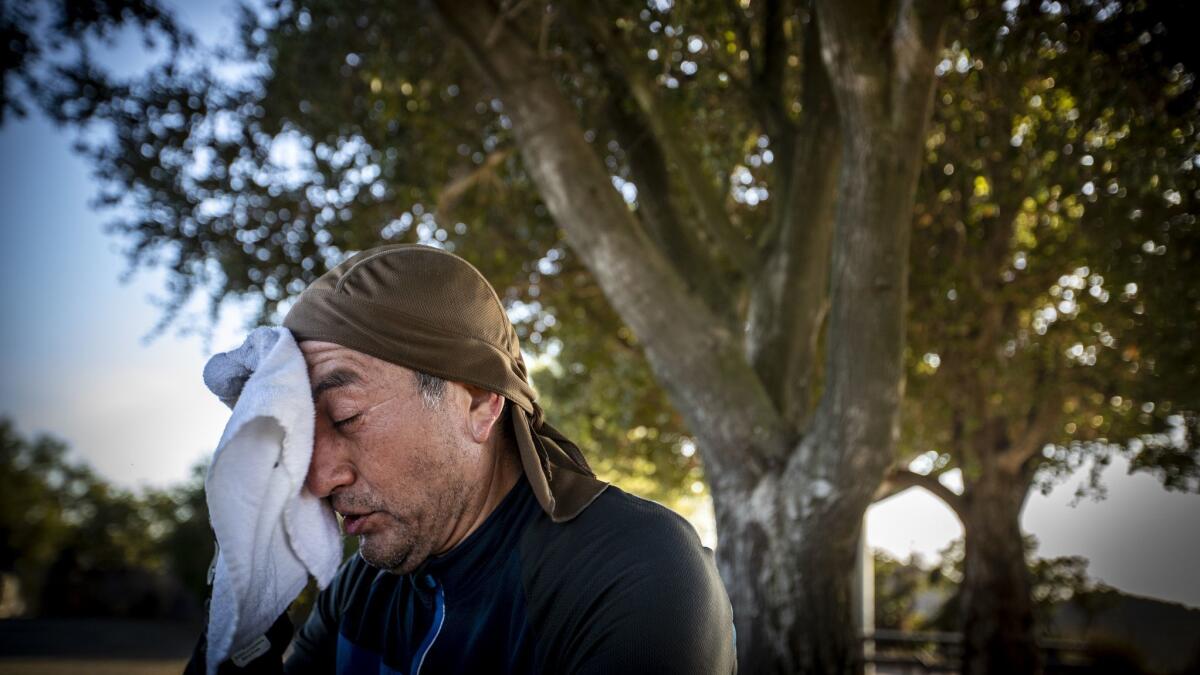Hitting Paris climate goals would save 759 lives in L.A. during huge heat wave, study finds

For decades, climate scientists have been designing models to predict global warming’s long-term ecological effects: sea level rise, coral bleaching, extinctions of entire species.
Researchers have now taken a step that hits closer to home, characterizing for the first time how various climate scenarios outlined in the Paris agreement could affect heat-related deaths in humans.
Spoiler alert: The results range from horrible to only marginally less horrible.
If no change is made to current climate commitments, the global average temperature could rise 3 degrees Celsius above pre-industrial levels by the year 2100, and with it will come the type of extreme heat waves that are expected to occur once every 30 years. Researchers predict about 20,240 heat-related deaths across 15 U.S. cities whenever such an event occurs.
But by limiting that temperature change to 2 or even 1.5 degrees Celsius — the goal of the Paris agreement — humans could prevent between 6,232 and 9,484 of those deaths, according to the research published Wednesday in the journal Science Advances.
Is it our constitutional right to live in a world safe from climate change? »
The findings come just in time for the next round of greenhouse gas reduction pledges, which are due from participating countries every five years. The study authors hope their results will motivate countries to boost their ambitions when it comes to cutting carbon emissions.
“When people talk about 2 degrees versus 3, you might think, ‘What difference does a degree make in our lives?’ But we’re talking about a huge difference, in thousands of lives,” said study leader Eunice Lo of the University of Bristol in England, who researches ways that climate change affects human health.
“There is hope in this data, and there is opportunity — but the window is closing really, really fast.”
The Paris climate accord was designed to keep the global average temperature “well below” a 2-degree Celsius increase from pre-industrial levels; their most optimistic plans would cap the increase at 1.5 degrees.
Lo and her colleagues took those goals and ran with them, combining an array of temperature and mortality data to try to imagine life and death when the U.S. is in a hotter world.
Researchers used a heat vulnerability index to measure the social and environmental factors that affect the likelihood of death during extreme heat waves. For example, out of all 15 cities, Los Angeles ranks worst in access to air conditioning. It’s among the top five in terms of the number of elderly residents and people with diabetes, Lo said.
In a scenario in which the global average temperature only warms 2 degrees Celsius instead of 3, L.A. could avoid an estimated 759 heat-related deaths during a once-in-30-years heat wave. If the temperature rise could be limited to 1.5 degrees Celsius, the number of lives saved could increase to 1,085, the data indicate.
Those numbers are second only to New York City, where an estimated 1,980 to 2,720 deaths could be averted depending on the global temperature rise.
Why the next decade will be critical in the fight against climate change »
In places like San Francisco, St. Louis and Boston, the number of potential deaths (and in turn, deaths prevented) during such heat events would be much lower. But under the 1.5- or 2-degree scenarios, all 15 cities would experience significantly fewer “hot days,” or days when the average temperature begins to cause deaths.
“There’s no question that, as the global average temperatures go up, a lot of people will become ill or die on days when there aren’t even official heat warnings.” said John Balbus, a senior advisor for public health at the National Institute of Environmental Health Sciences, who was not involved in the study.
“This is a sophisticated attempt to stratify the answer to the question on the minds of the decision-makers.”
In the future, these models could help individual cities customize their mitigation and resilience strategies. But even now, the researchers hope their findings will bolster the perceived urgency of climate change and the difference that individual citizens can make — even in the face of political opposition.
In 2017, the Trump administration announced the U.S.’ withdrawal from the Paris accord, effective in 2020. At least 23 states have committed to pursuing the goals within the agreement anyway.
“On a personal level, it’s important to do what we can to reduce our carbon footprint: biking, walking, and, yes, putting pressure on political figures,” Lo said. “This administration continues to deny the science of climate change. Hold them accountable — that’s all you can do.”
Lo, who plans to make predictions that account for the urban heat island effect next, said the impending global doom can be discouraging, but that children participating in recent school strikes and lawsuits make her work seem worthwhile.
“They’re doing the right thing and I’m proud of them — they aren’t even old enough to vote,” she said. “Now the power of all these future projections lies in the hands of adults.”







